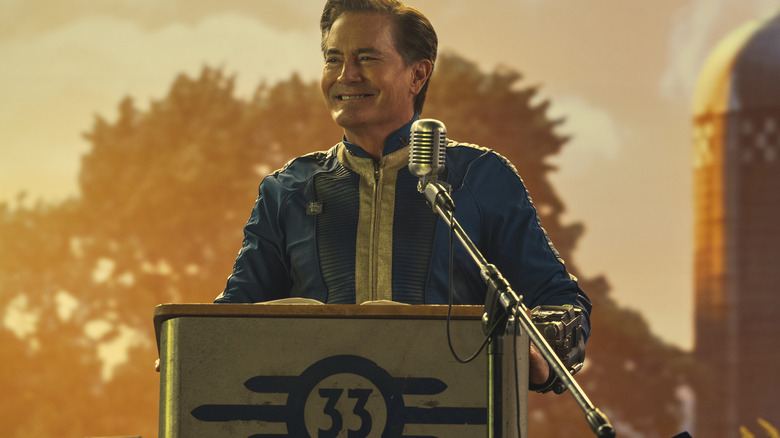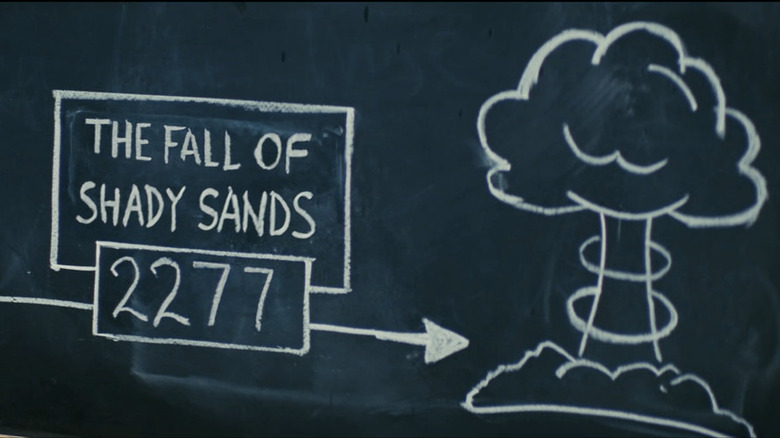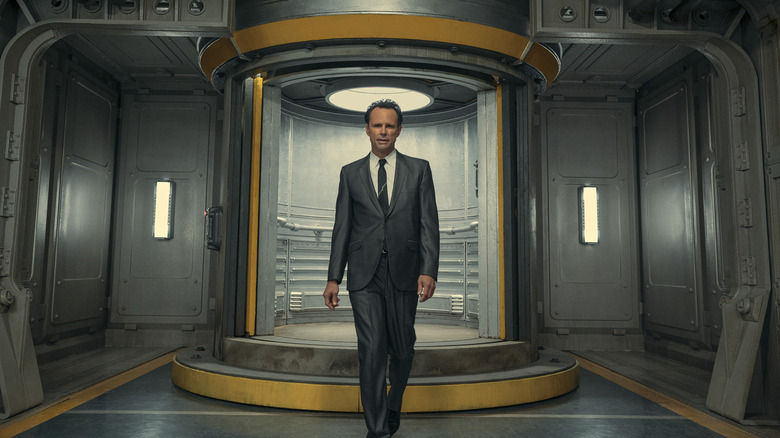Fallout Dev Sets The Record Straight On Timeline Controversy
Spoilers follow for the first season of "Fallout."
With "Fallout," Prime Video delivered one of the best video game adaptations ever, one that stands up there with the likes of "Arcane," "Cyberpunk: Edgerunners" and "Castlevania."
A big reason for the show's success is that it is not a 1:1 remake like, say, "The Last of Us." Instead, "Fallout" tells an entirely original story with brand new characters. There is some overlap, of course, from slightly similar plots to cheeky references and returning characters from the games, but otherwise, this feels less like replaying your favorite "Fallout" game and more like watching a brand new "Fallout" game play out in front of you.
This allows the TV show to tell a good and thrilling story without the restraints of canon or the games. This is how we get the entire pre-war storyline that gives us an origin for Vault Boy and a finale that shows the true evils of Vault-Tec in a way that not even the games fully get at by connecting them to the end of the world.
It is also how the show, set a decade after the events of the games, can bring in elements from any of them whenever it makes for a good story rather than because it is required. For example: how the show gives us Shady Sands and the New California Republic in ways much different than gamers would remember. Shady Sands in particular caused a bit of controversy among some fans who were left confused about the timeline of events and whether the show retconned the events of "Fallout New Vegas." When asked by fans whether the popular game remains canon or not, lead designer and writer of "Fallout 3" and "4," Emil Pagliarulo tweeted "Of course it is. We've never suggested otherwise."
The fall of Shady Sands
In one of the episodes we visit Vault 4, which hosts a whole bunch of mutants and survivors of a tragedy. We learn that a lot of them come from the city of Shady Sands, a bustling town in the wasteland, capital of the New California Republic introduced back in the first "Fallout" game. This is where Maximus was raised, and where Lucy lived for a while.
Then the city fell when a Vault-Tec employee, seeing the threat of a flourishing city on the surface not led by Vault-Tec, detonated a nuke that obliterated the entire Shady Sands. The problem seems to stem from a single shot of a chalkboard in Vault 4 that teaches the history of the New California Republic. The chalkboard puts the fall of Shady Sands as happening in 2277, followed by a drawing of a nuke exploding.
Fans believe this overlaps with the games, as "Fallout: New Vegas" is supposed to take place in 2281, and in that game, Shady Sands is a vibrant and very much intact town. This led some "Fallout" fans to claim that the "New Vegas" storyline was being retconned out of "Fallout" lore altogether. Given that "New Vegas" is the one main game in the franchise not produced by Bethesda Game Studios, who helped produce the show, it is reasonable to think they might want to erase the game from the new canon.
Except, as Bethesda game designer Emil Pagliarulo said, the game is very much still canon. So what happened to Shady Sands? Well, the date could simply be a mistake on the part of the "Fallout" TV show. Or perhaps it is a clever hint that season 2 will show us more of the decline of Shady Sands.
The end of the world as we know it
The question is, does this matter? After all, it is quite unlikely that this is an actual retcon, as the show could simply fix the date in the next season if it truly conflicts with the events of "Fallout New Vegas." Given that the season ends with a tease of the city of New Vegas, that's where we're likely heading, so Shady Sands is probably going to play a bigger role.
That's because, in the games, Shady Sands was an important city, the capital of the New California Republic which was at war with the city of New Vegas. In 2274, both parties signed a treaty that would provide electricity to the NCR while recognizing the sovereignty of New Vegas — while the former secretly tried to absorb the latter. In "Fallout New Vegas," the player can decide who to support and play an integral role in the future of the titular city and the NCR.
Given that "Fallout" season 1 shows the New California Republic as being in shambles, and Shady Sands destroyed, it is possible we will get a definitive canonical answer as to the ending of "New Vegas" and the fate of the titular city. In that case, the Fall of Shady Sands may not be a specific moment, but a slow decline, possibly due to the conflict with New Vegas and the fascistic Caesar's Legion faction. The timeline controversy may not be a retcon or even a mistake, but an opportunity for new and thrilling stories.


